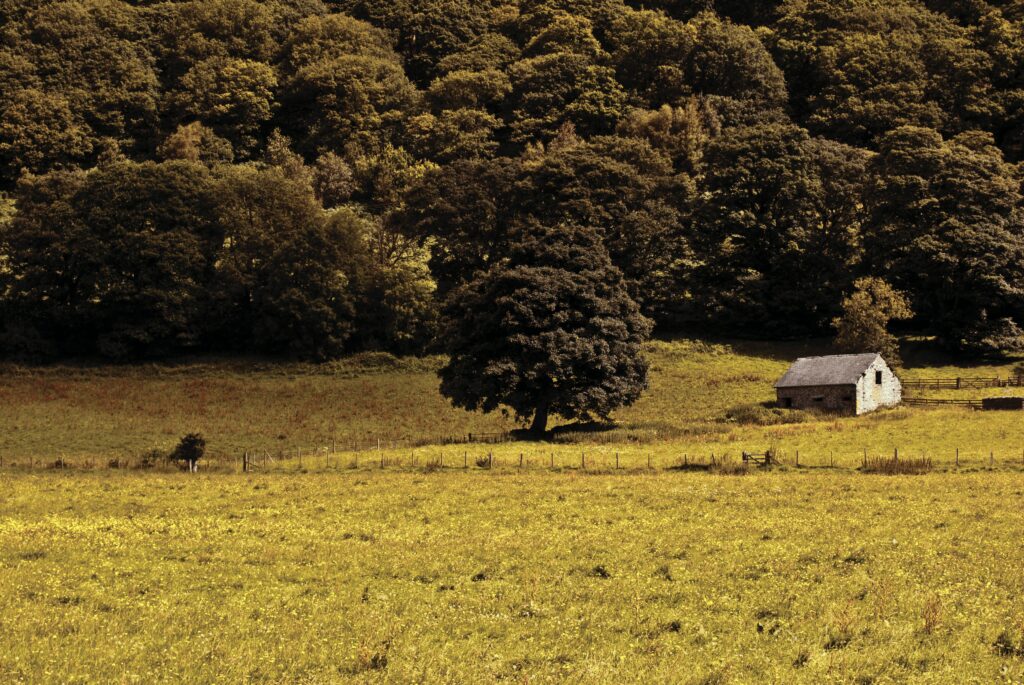Caitlin Lewis visits woodland creation projects in South East Wales in a bid to discover what factors are limiting the Welsh Government from reaching its tree-planting targets.
Wales is not on track to meet its tree planting targets. To achieve the Welsh Government’s objective to plant 43,000 hectares (ha) of new woodland by 2030, Wales needs to plant at least 5000 ha per year. A new report from Forest Research found that the area of new tree planting in Wales for 2022-23 was just 1190 ha. So, why is it proving so difficult to meet tree planting targets?
Here are some insights I gained during a two-day workshop I organised for early career researchers on behalf of the International Association for Landscape Ecology UK, where we visited woodland creation projects in South East Wales.
Failure to engage local communities
‘The past failure of the Summit to Sea rewilding project in North Wales haunts everyone in this line of work’ Robert Penn said.
We were all seated at the top of Bryn Arw, a steep hillside in the Bannau Brycheiniog National Park, recently planted with trees by the charity, Stump Up For Trees (Stump). Summit to Sea was a large-scale Rewilding Britain project until they withdrew their involvement in 2019, following a phenomenal amount of opposition from rural communities. Its downfall was a result of failure to consult with and listen to the stakeholders impacted by the project.
‘We learned from that though, and what we have done differently with Stump is listen to stakeholders at every step,’ Robert explained.
For example, Stump avoided new planting in a halo around a patch of existing birch trees for butterfly habitat on request of the Butterfly Conservation Trust, and left a patch unforested to provide suitable habitat for adders on request of the Amphibian and Reptile Conservation Trust.
Syniadau uchelgeisiol, awdurdodol a mentrus.
Ymunwch â ni i gyfrannu at wneud Cymru gwell.
Stump’s headline ambition is to plant one million trees across the Bannau Brycheiniog National Park, but recognise that the success of woodland creation cannot be measured through tree planting numbers. Rather, the focus lies in creating quality woodland habitat, containing a variety of native broadleaved species which are connected to pre-existing woodlands, along the bracken-covered strip that stretches across the Black Mountains.
Whilst some evidence suggests that the existence of bracken indicates the historical presence of woodland, the Black Mountains were likely deforested from as far back as neolithic times and used for livestock grazing since. To avoid the use of plastic tree guards to protect young trees from grazing livestock and deer, Stump installed a fence before planting its first trees two years ago. Fence installation is subject to many restrictions on common land, but through working with the commoners, Stump gained approval to make this move. Whilst the consultation process reduced Stump’s ambitions slightly, listening to the community has ultimately led to its success.
Whilst the consultation process reduced Stump’s ambitions slightly, listening to the community has ultimately led to its success.
The competition for land
Our next stop was Coed Hen Ffordd, Talgarth, with Jed Needs, the director of the Green Valleys community interest company. Coed Hen Ffordd was a National Lottery Heritage Fund (NLHF), community-centred planting project which encountered several challenges during its initial phases, including acquiring the land for the project.
The land originally proposed for the planting project was purchased by a buyer who offered a more competitive price than a community interest company. Jed noted he was grateful to the NLHF for their support, whilst the company scrambled to find an alternative piece of land that could still offer the proposed benefits of the project.
However, other funders may not be as understanding. We heard a similar story on our visit to Brynau Farm, a large-scale Woodland Trust woodland creation project in Neath, where acquiring the land also proved to be a lengthy process.
Balancing woodland creation with other interests
At Brynau Farm, I asked Chris Matts, Woodland Trust site manager for South Wales, why there appeared to be few large-scale woodland creation projects in South West Wales, and why tree planting projects in the area tend to be led by small community groups. He explained that land in the South West generally had higher agricultural value and was therefore reserved for food production. In contrast, the Bannau Brycheiniog National Park uplands generally have poor agricultural value.
The National Trust manages some large estates in South West Wales, but has little incentive to undertake large scale afforestation as its membership is driven by factors other than members’ desire to support woodlands. The National Trust’s tree planting efforts have recently focused around the planting of cherry blossom and hedgerow improvement within communities rather than new woodland creation.
Gofod i drafod, dadlau, ac ymchwilio.
Cefnogwch brif felin drafod annibynnol Cymru.
To find out more about farmers’ perceptions of tree planting, the final stop on our tour was a working dairy farm in Wenvoe managed by Abi Reader, the deputy president for the National Farmers Union Cymru, to see her research pilot.
During a bumpy ride in a 50-year-old Land Rover, Abi explained the challenge of finding a suitable location for the pilot. Once a field is planted with trees, it cannot be accessible to livestock as they would destroy the young trees, and it can no longer be rented to other farmers, leading to a significant loss of income for the farm.
As someone whose experience lies in dairy farming and not trees, Abi called in consultant Richard Edwards to guide the research pilot. Together, they developed an innovative project to grow trees that regrow from their roots so they can be harvested regularly to produce charcoal, which could then be applied to slurry to reduce ammonia emissions from the farm’s dairy herd. Abi and Richard hope that the pilot will provide proof-of-concept to give other farmers the confidence to adopt similar circular farming practices.
Training and retaining skills within rural communities
Abi and Richard explained that the expense of hiring qualified ecologists to fully estimate the biodiversity value of agri-environmental systems, and the lack of personal knowledge and experience, limits the adoption of agroforestry. Solutions to practical challenges, such as those caused by the small size of fields in Wales compared to those typically used for agroforestry in England, must also be found.
Solutions to practical challenges, such as those caused by the small size of fields in Wales compared to those typically used for agroforestry in England, must also be found.
We had previously heard about the issue of retaining skills within rural communities from Jed Needs, who is also a tutor for the Black Mountains College. According to a 2021 report by the Countryside Charity, unaffordable living costs, poor public transport, poor digital connectivity, and social isolation renders rural communities unattractive to young people, including those training in new farming, woodland management and agroforestry techniques.
Whilst the UK and its devolved governments have previously offered and developed new schemes to plan and fund woodland creation, what we heard suggests that land acquisition, community engagement, consultation, training and skills retention within rural communities are essential components of delivering on tree planting targets. New bottom-up mechanisms such as Local Nature Recovery Strategies in England may address some of these challenges in future but it seems unlikely they will accelerate tree planting rates before 2024.
This article has been amended to reflect the correct Provisional Woodland Statistics 2023 report by Forest Research (13/07/2023).
All articles published on the welsh agenda are subject to IWA’s disclaimer. If you want to support our work tackling Wales’ key challenges, consider becoming a member.
This article was edited by Gwenno Robinson thanks to the Books Council of Wales’ New Audiences Fund.





